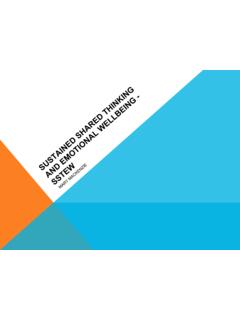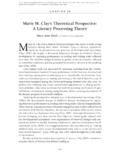Transcription of Every Child is a Writer Understanding the Importance of ...
1 Every Child is a Writer : Understanding the Importance of Writing in Early Childhood Anna H. Hall, Associate Professor of Early Childhood Education, Clemson University August 2019 Children want to write. They want to write the first day they attend school. This is no accident. Before they went to school, they marked up walls, pavements, newspapers with crayons, chalk, pens or that makes a mark. The Child s marks say, I am. Donald Graves Children as young as two years of age make marks on paper to express their feelings and communicate with Although toddlers and preschoolers may not write conventionally, they demonstrate their writing abilities in a variety of ways such as scribbling, drawing, and making letter-like forms.
2 The ways in which adults respond to children s first writing attempts can nurture or extinguish children s natural desire to write; therefore, it is critical for parents, teachers, administrators, and community stakeholders to understand the important stages of writing development and to encourage positive attitudes toward writing. Compositional writing refers to the act of using print to express meaning or to compose a story or nonfiction piece of writing. Handwriting refers to a less complex strand of development, which involves developing fine motor skills necessary to create print forms such as alphabet letters. Composing and handwriting develop alongside one another in order for young children to bridge their oral and written 2 Over the past twenty years, writing instruction has received increased emphasis in the United States.
3 In 2002, the National Commission on Writing in America s Families, Schools, and Colleges was established in an effort to focus national attention on the Importance of writing for all students in the 21st century. This commission argued that writing was not a skill for the few, but an essential skill for all students planning to enter the workforce. The first report issued by this commission, The Neglected R : The Need for a Writing Revolution,3 recommended doubling writing time in classrooms and providing resources for teachers to make increased instructional time possible. This brief addresses the Importance of fostering early writing skills in early childhood; research-based barriers and opportunities for writing in early childhood environments; and the policy considerations related to early writing development.
4 The primary audience is early childhood teachers and administrators; recommendations are also made for families and community stakeholders. BENEFITS OF EARLY WRITING INSTRUCTION Research on early writing instruction suggests that experimenting with composing helps children develop phonological awareness, alphabet knowledge, and print awareness, which are skills associated with future reading and writing Early childhood research also supports the development of foundational early writing skills as a means of promoting higher-level composition skills such as organizing, planning, and revising5, as well as future legibility and speed in The National Early literacy Panel (NELP)
5 Report7 concluded that name-writing skills yielded significant correlations with later reading abilities including decoding, reading comprehension, and spelling. Likewise, the National Research Council (NRC) reported key early writing skills ( , writing uppercase and lowercase letters independently, writing unconventionally to express meaning, and writing letters and some words when dictated) as necessary targets of interventions to prevent future reading Key Concepts of Early literacy Alphabet knowledge: letter identification and letter-sound knowledge Concepts of print: ability to recognize how print works especially with regards to books (includes directionality, book characteristics, purposes of genres, etc.)
6 Decoding: ability to pronounce written words by applying knowledge of letter-sound relationships and letter patterns Fine motor skills: coordination of small muscle movements in the fingers, hands, and forearms Letter recognition skills: ability to visually recognize and name individual letters in the alphabet Phonological awareness: the ability to recognize that words are made up of sounds Print awareness: functions, forms, and conventions of written language Reading comprehension: ability to use background knowledge to process and construct meaning from text 3 HOW IS EARLY WRITING DEVELOPMENT SUPPORTED BY theory AND RESEARCH?
7 Since the late 1970s, emergent literacy (a term coined by distinguished literacy researcher Marie Clay) has been the dominant theoretical perspective on early reading and writing. Emergent literacy theory supports the development of writing in a social context where children can learn about the meaning and process of writing by observing and interacting with teachers and other children. Emergent literacy encourages teachers to make writing materials readily available and give children time to write freely. This theory also posits that reading and writing are reciprocal and interrelated processes. Writers have to know what readers do and readers have to know what writers do.
8 The two processes contribute to each other during early literacy learning and are equally important for future academic Research on early childhood preschool writing suggests adult modeling and guidance are also critical for teaching students how and when to apply writing Therefore, embedding instruction within learning centers and authentic literacy activities in preschool and kindergarten can provide a balanced approach to literacy In the primary grades, research has described a strong link between process-oriented teaching practices ( , choice of topic, extended opportunities to write, and showcasing student work) and students' positive attitudes toward In 2012, What Works Clearinghouse released an educator s practice guide entitled Teaching Elementary School Students to Be Effective Writers.
9 13 In this guide, it is recommended that teachers: 1. provide daily time for students to write, 2. teach students to use the writing process for a variety of purposes, 3. teach students to become fluent with handwriting, spelling, sentence construction, typing and word processing, and 4. create an engaged community of writers. 4 WHAT ARE THE PHASES AND DIMENSIONS OF WRITING DEVELOPMENT? As infants near their first birthday, they may begin imitating adults and experimenting with writing tools. From there, early writing development follows a similar trajectory into the early grades, outlined in Figure 1: Figure 1: Phase of early writing development14 All children move through these phases in order, the phases do overlap, and children may use a combination of techniques described in the different phases concurrently.
10 The dimensions of early childhood writing include both lower level transcription skills (handwriting and spelling) and higher level executive skills (generating ideas, organizing, and revising during composing).15 When school-age children perform lower level skills automatically, they have more working memory available for higher level skills and they are able to translate language in their minds into written text more Lower Level Transcription Skills Handwriting: Limited research exists on the development of handwriting and handwriting practices in preschool. In a recent review of experimental studies investigating preschool writing instruction, Hall and colleagues (2015) found only three studies that focused on Other researchers18 have found that preschool children participating in a particular program, Handwriting Without Tears,19 scored significantly higher on instruments measuring prewriting skills, kindergarten readiness, and fine motor skills than children that did not participate in the handwriting program.






